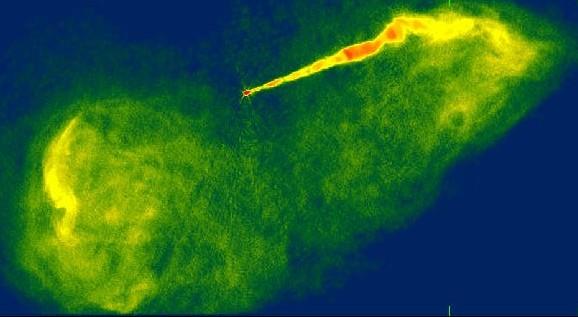
An image of the galaxy M87 and its jet at radio wavelengths; the length of the jet is about 5000 light-years. A small knot in the jet has been found to be a source of both bright, variable X-rays, apparent faster-than-light motions, and gamma-ray emission.
In 1774 the French astronomer Charles Messier published a catalog of 109 fuzzy-looking objects he discovered in the heavens. He thought they might be mistaken for comets, and today we know that many of them are actually galaxies. In the last century, radio astronomers discovered that the galaxy Messier 87 was dramatically different from most other galaxies, and from our own Milky Way: it has a narrow jet thousands of light-years in length streaming outward from its nucleus.
Astronomers suspect that a massive black hole at the center of M87 drives these powerful jets as matter falls into it, releasing energy. Astronomers also think that the Milky Way has a massive black hole at its core, and so they wonder what makes the Milky Way so quiescent, and
M87 so violent.
In 2002, CfA astronomers using the Chandra X-ray observatory discovered that a luminous knot in the M87 jet relatively close to the nucleus (only about 500 light-years out) was variable in its intensity over a period of a month. They then began to monitor the knot in the radio at very high spatial resolutions. In a paper in this week's Astrophysical Journal Letters, SAO astronomer Daniel Harris and two colleagues report discovering that, in addition to being bright and time variable, this knot is composed of smaller clumps each about five light-years in diameter that are apparently moving at speeds faster than the speed of light. These so-called "superluminal motions" are not uncommon in galaxies with radio jets. They are the result of an illusion that sometimes occurs when material in a jet is moving at nearly the speed of light and is ejected in a direction almost exactly towards us; when this occurs, the jet appears to us to be traveling away from the core at speeds exceeding the speed of light.
The knot in the M87 jet is the only known example of a source with both variable, energetic processes and superluminal motions. The astronomers argue that the two processes are not accidentally coincident -- they are physically associated. Furthermore, M87 is known to emit very intense gamma ray radiation, light whose energies are nearly a million times greater than typical X-rays. The scientists argue that this gamma-ray emission arises not from the regions around the black hole nucleus, as is typically supposed, but from within this knot and its dramatic environment. The results suggest that in many other galaxies showing gamma ray emission and related phenomena the activity also comes from material located away from the nucleus. The results not only help to explain how these phenomena arise, they demonstrate that they can arise in ways that are not directly due to a black hole, and so might occur even in galaxies less flamboyant than the one Charles Messier numbered as 87.